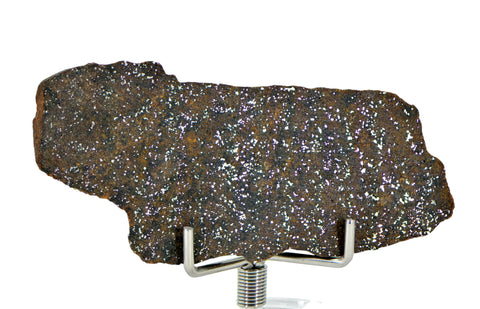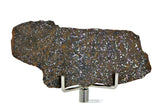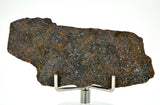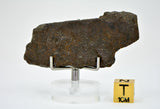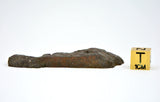18.76g Errachidia 004 I Winonaite Anomalous Primitive Achondrite Meteorite End Piece
On Offer: 18.76 gram primitive achondrite Errachidia 004 end piece. An exceptional and intriguing primitive meteorite specimen from an unknown partially differentiated parent body.
Official Name: Errachidia 004
Classification: Primitive Achondrite (Winonaite - anomalous)
Year found: 2020
Country: Morocco
Description: 18.76 gram end cut of Achondrite-prim-ung meteorite with official name Errachidia 004. Many small stones and fragments covered with a weathered fusion crust were found. 75% of the stones contain low amounts of visible metal; the remaining 25% contain high amounts of visible metal.
What you get: 18.76 gram Errachidia 004 specimen as shown, shipping/storage membrane box, and signed Certificate of Authenticity.
We offer a 100% no questions asked 30 day return policy.
| Errachidia 004 | |||||||||||||||||||||||||||||||
|---|---|---|---|---|---|---|---|---|---|---|---|---|---|---|---|---|---|---|---|---|---|---|---|---|---|---|---|---|---|---|---|
| Basic information |
Name: Errachidia 004 This is an OFFICIAL meteorite name. Abbreviation: There is no official abbreviation for this meteorite. Observed fall: No Year found: 2020 Country: Morocco Mass: 2.64 kg |
||||||||||||||||||||||||||||||
| Classification history: |
This is 1 of 2 approved meteorites classified as Winonaite-an. Search for other: Primitive achondrites, Winonaites |
||||||||||||||||||||||||||||||
| Comments: | Approved 13 Mar 2021 Revised 18 Jun 2024: reclassified anomalous |
||||||||||||||||||||||||||||||
Writeup |
Writeup from MB 110:
Errachidia 004 32°2.418’N, 4°4.092’W Errachidia, Morocco Find: 2020 Classification: Primitive achondrite (Winonaite) History: Found in 2020 by Mustapha Oulkouch and other finders in a strewnfield centered within the isolated rural community of Oued Naam. Later purchased by Sean Mahoney in February 2020. Physical characteristics: Many small stones and fragments covered with a weathered fusion crust. 75% of the stones contain low amounts of visible metal; the remaining 25% contain high amounts of visible metal. Petrography: (D. Sheikh, FSU) This sample features two distinct lithologies: 1) A low-metal lithology (<10 vol% metal) displaying a predominantly granoblastic texture composed of forsterite, enstatite, augite, and sodic plagioclase (Silicate grain size Av. 110±50 µm) with the mineral grain boundaries meeting at approximately 120° triple junctions. Kamacite and troilite are finely scattered throughout the interior as either veinlets or individual grains; some have been altered to form Fe-oxides. No chondrules were observed. 2) A high-metal lithology (up to 80 vol% metal) displaying a well-developed Widmanstätten pattern containing kamacite, taenite, plessite, and accessory troilite and schreibersite (kamacite band width Av. 2 mm, range 1-3 mm), and containing angular silicate inclusions of sodic plagioclase (some containing melt inclusions), augite, and enstatite (Silicate grain size Av. 350±50 µm). No chondrules were observed. Geochemistry: Low-metal lithology: Forsterite (Fa0.8±0.3, range Fa0.4-1.4, FeO/MnO=2±1, n=30), Enstatite (Fs4.3±0.6 Wo1.7±0.2, range Fs1.6-4.9 Wo0.8-2.0, FeO/MnO=4±1, n=22), Augite (Fs2.0±0.4 Wo45.0±1.0, range Fs1.2-2.6 Wo44.1-46.7, Na2O=0.7±0.2 wt%, Cr2O3=1.1±0.6 wt%, FeO/MnO=3±1, n=7), Sodic Plagioclase (An10.8±0.8 Or4.0±1.6, range An10.2-11.4 Or2.8-5.1); High-metal lithology: Sodic Plagioclase (An12.2±2.6 Or3.9±0.6, range An9.7-19.5 Or1.9-5.3), Augite (Fs2.4±0.3 Wo43.0±1.1, range Fs1.8-3.0 Wo39.9-45.7, Na2O=0.9±0.1 wt%, Cr2O3=1.5±0.1 wt%, FeO/MnO=3±1, n=19), Enstatite (Fs4.5±0.5 Wo1.8±0.3, range Fs3.9-5.7 Wo1.4-2.2, FeO/MnO=4±1, n=8). Oxygen isotopes (K. Ziegler, UNM): analyses of acid-washed subsamples by laser fluorination gave, respectively, Low-metal lithology: (δ17O 2.296, 3.022, 2.588; δ18O 5.276, 6.655, 5.843; Δ17O -0.489, -0.491, -0.497 per mil), High-metal lithology: (δ17O 3.940, 2.666, 2.577; δ18O 8.197, 6.019, 5.881; Δ17O -0.388, -0.512, -0.528 per mil). ICP-MS data of metal separates from high-metal lithology, using sample of North Chile (Filomena) as standard (C. Herd and P. Hill, UAb): Ni = 7.4, Co = 0.30 (both wt%); Ir = 5.9, Ga = 28, Ge = 123, As = 10.1, Ru = 5.0, Re = 0.5, Os = 13.6, Pt = 9.5, Cu = 180, Au = 0.85 (all μg/g). Specimens: 25.2 g type specimen and two polished thin sections (one of each lithology) at UNM; 397 g high-metal and 905 g low-metal with Sean Mahoney, 65 g high-metal and 50 g low-metal with Juan Aviles Poblador, 215 g high-metal and 85 g low-metal with Kyle Josefy, 800 g low-metal with Mark Lyon, 61 g high-metal and 61 g low-metal with Topher Spinnato. Writeup from MB 113:
Errachidia 004: reclassification
(D. Sheikh, Cascadia): Although winonaites can display various textures and compositions, Errachidia 004 is unique compared to other winonaites in that it represents a polymict assemblage of various different winonaite lithologies, e.g., ultramafic and basaltic (Sheikh, 2021). Although the low metal lithology displays the commonly observed ultramafic assemblage characteristic of most winonaites, the high metal lithology displays an overall basaltic texture and unique variation in mineral modal abundance, with some pieces consisting of >50 vol. % plagioclase and no olivine (as similarly observed in recently classified NWA 15487). Other lithologies, with >70 vol. % Fe-Ni metal, are "transitional" between metal-bearing winonaites and silicate-bearing IAB iron meteorites. In some cases, high- and low-metal lithologies are juxtaposed against each other. Overall, Errachidia 004 is unique among winonaites and should be designated as anomalous. |
||||||||||||||||||||||||||||||
| Bibliography: |
|
||||||||||||||||||||||||||||||
| Data from: MB110 Table 0 Line 0: |
|
||||||||||||||||||||||||||||||
We Also Recommend

